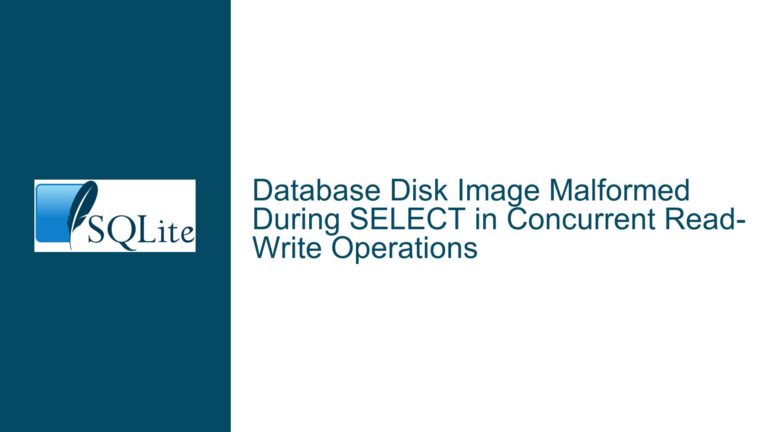Handling Corrupted SQLite Databases During INSERT SELECT Operations
Understanding the Corruption and Its Impact on INSERT SELECT
When dealing with a corrupted SQLite database, one of the most critical issues arises during data migration or copying operations, particularly when using the INSERT INTO ... SELECT statement. The corruption in the source database can manifest in various ways, such as duplicate primary keys, missing rows in indexes, or mismatched entries between tables and their corresponding indexes. These issues can lead to unexpected behavior during data transfer, especially when the SQLite query optimizer employs optimizations that bypass thorough data validation.
In the observed scenario, the source database contains a table fp with a composite primary key on columns a and b. Due to corruption, there are duplicate rows with identical primary key values, and the associated indexes are missing entries or contain incorrect counts. When attempting to copy this table to a new database using INSERT INTO dst.fp SELECT * FROM fp, the operation succeeds without errors, but the corruption is propagated to the destination database. This happens because SQLite employs a transfer optimization that copies raw data without decoding or validating individual records, effectively bypassing the corruption checks.
The expected behavior, however, is for the operation to fail with a UNIQUE constraint failed error, as the destination table should enforce the primary key constraint. This discrepancy highlights the challenges of handling corrupted databases and the importance of understanding SQLite’s internal optimizations.
Why SQLite’s Transfer Optimization Bypasses Corruption Checks
SQLite’s query optimizer includes a specific optimization for INSERT INTO ... SELECT statements, known as the "transfer optimization." This optimization is designed to improve performance by copying raw data from the source table to the destination table without decoding or reassembling individual records. While this approach is highly efficient for valid data, it can inadvertently propagate corruption when the source database is compromised.
The transfer optimization is triggered under specific conditions, such as when the source and destination tables have compatible schemas and the destination table is empty. When these conditions are met, SQLite skips the usual record-by-record processing and performs a bulk transfer of raw data, including index entries. This behavior explains why the corruption in the source table fp is copied to the destination table dst.fp without triggering the expected UNIQUE constraint failed error.
The optimization is particularly useful for operations like VACUUM, where performance is critical. However, it becomes problematic when dealing with corrupted databases, as it bypasses the mechanisms that would normally detect and prevent the propagation of invalid data.
Strategies for Detecting and Resolving Corruption During Data Transfer
To address the issue of corruption propagation during INSERT INTO ... SELECT operations, several strategies can be employed. These strategies focus on forcing SQLite to process records individually, thereby enabling the detection of corruption and enforcement of constraints.
One effective approach is to modify the SELECT statement to include a LIMIT clause, such as LIMIT 1, 9223372036854775807. This forces SQLite to process records one by one, ensuring that each row is decoded and validated before insertion. While this method works, it has limitations, such as the inability to handle the theoretical maximum number of rows (2^64-1) due to SQLite’s internal constraints.
Another strategy involves using a temporary table with a WITHOUT ROWID clause. This approach ensures that the table is scanned and processed row by row, preventing the transfer optimization from being applied. The steps for this method are as follows:
- Create a temporary table
temp.fpwith the same schema as the source tablefp, but include an additionalrow_idcolumn to handle potential duplicates. - Use the
WITHOUT ROWIDclause to force a full table scan during theINSERT INTO ... SELECToperation. - Copy the data from the source table
fpto the temporary tabletemp.fp. - Transfer the data from the temporary table
temp.fpto the destination tabledst.fp. - Drop the temporary table
temp.fpand remove therow_idcolumn from the destination table if necessary.
This method ensures that the data is thoroughly validated during the transfer process, preventing the propagation of corruption. Additionally, it provides an opportunity to clean up or repair the data before inserting it into the destination table.
In conclusion, handling corrupted SQLite databases during INSERT INTO ... SELECT operations requires a deep understanding of SQLite’s internal optimizations and a proactive approach to data validation. By employing strategies such as modifying the SELECT statement or using temporary tables, developers can ensure that corruption is detected and resolved before it affects the destination database.






